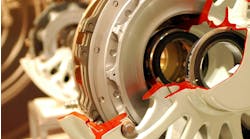Harvesting the Benefits of Autonomous Agricultural Machinery
The agricultural industry is experiencing a global labor crisis, with significantly reduced numbers of farmers and agricultural workers entering the industry than ever before. Unfortunately, there is not much relief in sight.
The number of agricultural workers is expected to increase just 1% from 2019 to 2029, according to the U.S. Bureau of Labor Statistics, with fewer than 10% of farmers globally being under the age of 40.
This ongoing labor shortage is expected to impact food production across the country. According to the World Wildlife Foundation, an estimated 10 million tons of specialty crops grown on farms each year never gets harvested or makes it past the farm gate.
To compensate for the current labor shortage and help reduce food waste, many farmers are turning to autonomous technology. And hydraulic systems are playing in important part in these machines.
The Role of Hydraulics in Autonomous Agricultural Equipment
Agricultural equipment is a key market segment for the hydraulics industry. As machines in this sector become more automated, so too are hydraulic systems to help improve equipment performance, reduce downtime, enhance safety as well as improve energy efficiency and control costs.
By leveraging advanced sensors, control systems and actuators, agricultural equipment manufacturers can now automate their hydraulic systems, allowing equipment – both traditional and autonomous versions – to perform tasks with greater precision and accuracy.
READ MORE: Opportunities and Challenges for Fluid Power in Automation
Automated hydraulic systems are often used to power attachments such as plows, cultivators and hay balers, resulting in faster and more efficient production time and reduced labor costs.
These hydraulic systems have been shown to offer several benefits that can positively impact farming operations, including:
- Increased Efficiency: Compared to traditional agricultural machinery, autonomous equipment that utilizes hydraulic solutions leads to reduced manual intervention, improved system response time and increased efficiency and precision. This can result in lower labor costs, increased productivity, improved safety and higher throughput.
- Improved Safety: Agricultural operations can involve hazardous conditions, and can be dangerous to operate manually. Autonomous equipment outfitted with hydraulics eliminates the need for manual intervention. For example, autonomous sprayers can control the amount of pesticides applied to crops through detection camera technology, making way for increased precision spraying and reduced exposure to chemicals as a result.
- Reduced Downtime: Downtime in farming operations can result in significant losses in productivity and revenue. Incorporating electro-hydraulic and remote monitoring solutions into autonomous agricultural machinery can help minimize downtime by detecting and diagnosing faults remotely, and automatically correcting them before they cause serious damage.
- Lower Maintenance Costs: Traditional hydraulic systems require ongoing maintenance, including oil changes and filter replacements. In comparison, smart hydraulic technologies collect real-time data and detect issues before they cause significant damage, reducing the need for frequent maintenance and repairs.
Examples of Autonomy in the Agricultural Industry
Several types of autonomous machines have started to become available in the agricultural industry, with many more under development and likely to enter the market in the coming years. Depending the design, these machines can provide semi- or fully-autonomous operation to help farmers remain productive despite labor shortages.
- Autonomous Tractors: With a GPS guidance system and camera sensors for obstacle detection, autonomous tractors will continuously monitor virtual geofencing. Farmers will be able to access their fleet of tractors via their smart devices, accessing live videos and data, alongside the ability to remotely monitor their machines and adjusting where necessary. Artificial intelligence is also trained to identify any abnormalities, and alert the farmer via a notification system of any issues that arise.
- Autonomous Planters: An autonomous rice planter, for example, enables more precise work, with minimal labor requirements. The autonomous machine uses remote control monitoring to allow the farmer to control the machine from afar and includes the technology to allow the machine to move autonomously in straight movement with equal hill space functions. Autonomous planters require hydraulics for various drive technology functions, including precision control – where the machine places plants at equal distance in a row, as well as hydraulic adjustmentof bidirectional reinforcement wheels.
- Autonomous Harvesters: Harvesters already have a high degree of automation as standard with machines like grape harvesters using computing hardware to harvest the crops through three vision algorithms – grape cluster detection, ripeness estimation and grape stem detection – resulting in reduced food waste. Autonomy within the harvesting sector is set to increase further to prioritize precision agriculture, leading to higher efficiencies and increased productivity.
- Auxiliary Vehicles: Through the introduction of automation, auxiliary vehicles (multifunctional robot tractors) will have autonomous drive which is carried out by using GPS field mapping, and collect and use data as well as an autonomous navigation system using cameras and GPS to steer accurately on a required route, avoiding crops and obstacles in its path. Autonomous robots can also be linked to IoT (internet of things) systems which monitor fertilizer application, leading to additional savings for farmers.
READ MORE: Perception Systems Guide the Path to a Fully Autonomous Tractor
When introducing autonomous equipment into a farming operation, it is important to choose the right partner to help make the transition. This includes training on the use of the electrohydraulic control systems included on autonomous machines as well as support for troubleshooting and maintenance.
While the initial investment in autonomous technology may seem high, the long-term benefits make it a worthwhile one. It will ultimately help farmers improve their bottom line, stay competitive and thrive in a rapidly evolving marketplace.
This article was written and contributed by Megan Tolley, PR & Marketing Coordinator at HydraForce Ltd.



